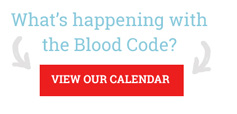The Double Thrift of Hypothyroid: 5 revealing blood tests
Richard Maurer, ND
Author of The Blood Code: Unlock the secrets of your metabolism, (2014)
The thyroid gland has become an unruly scapegoat in the pasture of self-help and wellness. As clinicians we can attribute fatigue, irritability, weight gain, low libido, depression, brain fog, hair loss, poor complexion, and digestive symptoms—to a thyroid problem. But to fully blame a small set of hormones, while enticing, is likely in error. There is a companion to this goat and it can’t be neglected.
For decades, research has linked cardiovascular risk with high/normal TSH levels – a condition referred in the literature as mild, or subclinical hypothyroidism (SCH). These vague terms are unusual for good science, but researchers copied each other for years and had no other way to describe the phenomena of slight elevations in TSH (3-6 uIU/mL) with T4 and T3 within their reference ranges. Since 2004 though, two lines of research have shed light on non-thyroid reasons for mild TSH elevations. One has spawned a new understanding of the remarkable tissue specific enzymes called deiodinase 1, 2 and 3 (DIO 1, 2, 3)[i] [ii] and the other has shown the driving force of insulin resistance.[iii]
With a better understanding of the DIO enzymes, we are no longer confined to the simple thyroid cascade of hormones as the regulator of thyroid function. Furthermore, the study of the activation and deactivation of thyroid hormones with the DIO 1, 2 and 3 has told a story of our innate preference to preserve capital when times are tough—Through peripheral control, we burn less precious calories at rest. This advantageous trait goes hand in hand with insulin resistance, and clinically relevant research shows us that glucose homeostasis actually drives the regulation of T3 via DIO control.[iv] Low T3/T4 ratios are driven by the expression of insulin resistance.[v] Taken as step further, some persistent researchers looked to see if TSH was driving this train and lo, T3/rT3 reduced independent of TSH but in response to insulin resistance.[vi]
Terms like “Sick”, “Bad”, “Hypo” & “Depressed” present an unfortunate villain. The findings and symptoms that point the blame to your thyroid gland may be your body’s brilliant adaptation to a prior difficult and glucose deprived world
“I have been and still am a seeker, but I have ceased to question stars and books;
I have begun to listen to the teaching my blood whispers to me.”
Hermann Hesse, from Demian
The Blood Code – Step One
I personally have the extraordinary trait toward insulin resistance and a familial tendency to type 2 diabetes. I therefore live enthusiastically and gratefully in accordance with my glucose thrifty metabolism. In the first decade of my integrative medical practice I was one of the many doctors that helped patients creatively and proactively address mild or subclinical thyroid “problems” – relying on natural and personalized thyroid prescriptions. But over the more recent decade, research has corresponded with my clinical experience—so many “hypothyroid symptoms” were not, in fact, driven by the thyroid, but through mis-managed insulin resistance (IR). Once identified correctly, vitality could return through proper fitness habits and an appropriate dietary carbohydrate restriction.
Over 40% of people in the U.S. express IR. But is you sample only those people with hypothyroidism, it is even higher—if you have hypothyroidism, it is more likely that you express insulin resistance too.
Five Blood Code Tests to Assess Your IR, in addition to your proper thyroid evaluation: Map results through The Blood Code
The Blood Code Progress Panel – drawn in the morning, fasting & prior to exercise or other stimulants
- Complete Blood Count with Differential
- Comprehensive Metabolic Panel (CMP): For Liver enzymes & Glucose
- Serum Insulin: Calculate your HOMA-IR: Quantifies Insulin Resistance
- Lipid Panel: Calculate your Triglyceride : HDL ratio – Quantifies Your Storage
- HgbA1C – a calculation of 8-12 wk average blood sugar.
[add Vitamin D & Ferritin if not run in the prior 2 years]
What does it mean?
First, as you probably know, you will need to take an active role in your medical assessment and interpretation. Don’t expect your doctor to order the proper panel of fasting blood tests unless you specifically request. Your lipid panel, which includes triglyceride and HDL-cholesterol is commonly done, so is your Comprehensive metabolic panel and CBC. But you need to assure you also get your insulin and HgbA1c measured on the same fasting blood test.
Once evaluated: you are ready to learn the actionable insights to your non-thyroid metabolism. The Blood Code will help you become your own personal health and wellness expert through these metabolic blood tests. You can look over the book at: https://www.amazon.com/The-Blood-Code-Secrets-Metabolism/dp/0991218108
Is your HOMA-IR close to 1 as desired or drifting over 2? You can find the HOMA-IR calculator at https://thebloodcode.com/_old/homa-ir-calculator/
Dietary Guidelines For Insulin Resistance
After you have discovered your level of insulin resistance, find your carbohydrate tolerance—the lowest carbohydrate intake should be at breakfast. You will receive a comprehensive guide that allows you to categorize your level of insulin resistance when you sign up at TheBloodCode.com.
- Without insulin resistance: TOTAL: 130–200 grams (about 550–800 calories)
- Slight insulin resistance: TOTAL: 100–150 grams (about 400–600 calories)
- Moderate insulin resistance: TOTAL: 50–90 grams (about 200–400 calories)
- Severe insulin resistance: TOTAL: 25–40 grams (about 100–200 calories)
* These gram ranges are based upon a diet of about 2,000 to 2,800 calorie
Fitness Guidelines For Insulin Resistance
Your Fitness habits need to tap into the storage tank. With insulin resistance, you may not have high glucose in the bloodstream; you also have extra stored sugars in your liver, tissues, and muscles. If left to sit there, this extra sugar promotes inflammation—you need to actively clear it out. The encouraging word I can give you is that any exercise lowers your blood sugar; however, once your body has begun to express IR, gentle aerobic exercise will not help you move toward the more healthy insulin sensitivity. With hypothyroid, you will need morning exercise—enough to warm your cellular engines a little.
The Blood Code Fitness Principles cover the scientifically proven ways to recover your healthy metabolism.
- Exercise on an empty stomach.
- Exercise strenuously and vigorously.
- Engage many muscle groups whenever possible.
- Vary your heart rate throughout.
Diet, fitness, and lifestyle—they must all connect. Just like the thyroid activity connects to your non-thyroid mediated metabolism. Your blood test results help take the guesswork out of your dietary and exercise choices and become the tools that allow you to create your current and future health.
[ii] Agereben, B, et al. Activation and inactivation of thyroid hormone by deiodinases: local action with general consequences. Cell Mol Life Sci 2008 Feb;65(4):570-90.
[iii] Maratou E, et al. Studies of insulin resistance in patients with clinical and subclinical hypothyroidism. Eur J Endocrinol. 2009 May;160(5):785-90.
[iv] Chidakel A, et al. Peripheral metabolism of thyroid hormone and glucose homeostasis. Thyroid 2005 Aug;15(8):899-903.
[v] Farasat T, et al. Hyperinsulinemia and insulin resistance is associated with low T(3)/T(4) ratio in pre diabetic euthyroid pakistani subjects. J Diabetes Complications. 2012 JUL;26(6) 522-525.
[vi] Ruhla S, et al. T3/rT3-ratio is associated with insulin resistance independent of TSH. Horm Metab Res. 2011 Feb;43(2):130-4.




Comments are closed.